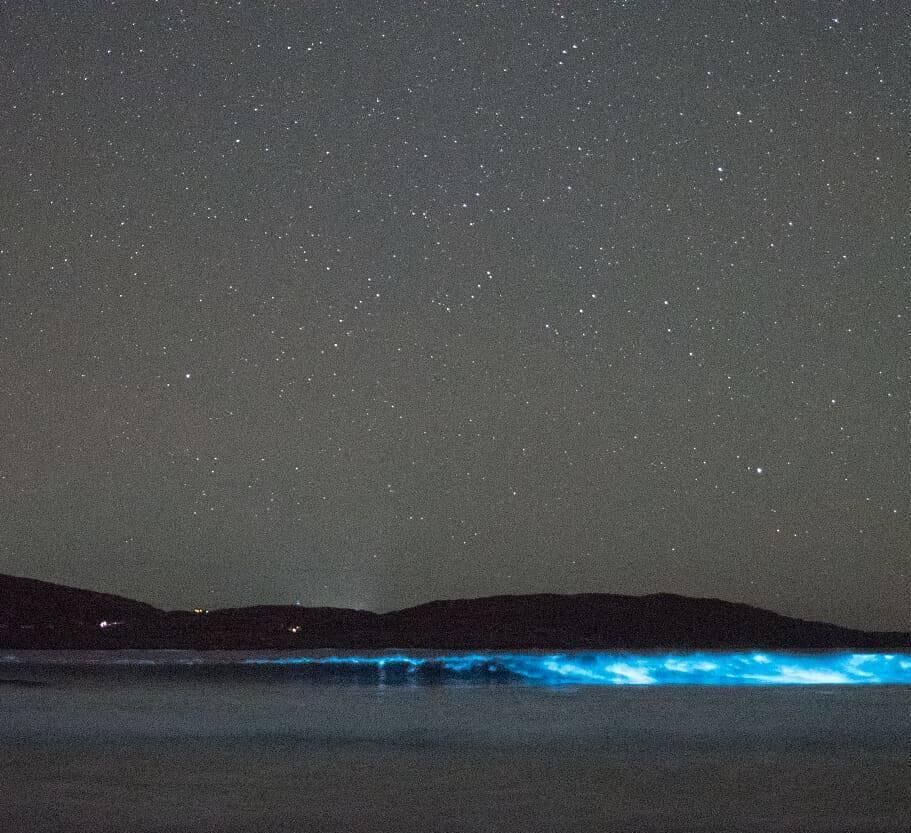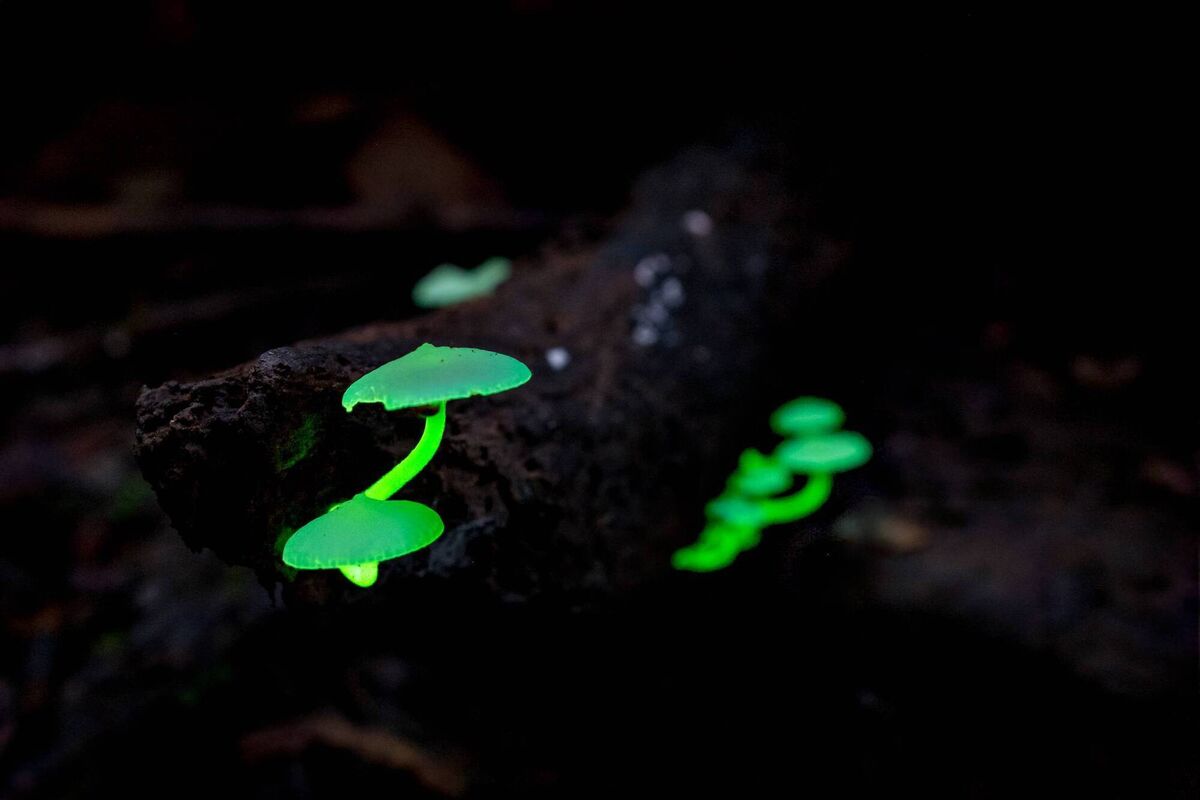Michelle McKeown: Shedding light on the wild world of bioluminescence

Bioluminescent waves illuminating the shoreline
On certain calm summer nights in West Cork, something remarkable happens beneath the surface of Lough Hyne. As paddles cut through the water or fish dart below, the dark lake bursts into shimmering streaks of blue-green light. This dazzling glow isn’t a trick of the moon or a trick of the eye.
It’s bioluminescence — the ability of living organisms to produce their own light. While it feels magical, it’s the result of a finely tuned natural chemical reaction, and it’s just one example of how widespread, and surprisingly practical, this glowing phenomenon is across the natural world.
The glow in Lough Hyne comes courtesy of dinoflagellates (tiny, single-celled plankton) floating near the surface of the water. When disturbed, they emit a flash of light, usually bluish green, in a rapid chemical reaction involving the molecules luciferin and luciferase. The prevailing hypothesis is that this burst of light acts as a kind of underwater burglar alarm, startling predators or even drawing in larger ones to gobble up whatever is trying to eat the dinoflagellates.

Although associated with tropical locales like the Maldives or Puerto Rico, bioluminescent waters do occur in Ireland. Along with Lough Hyne, sightings have been reported in sheltered bays in Kerry, Donegal, and along the south coast, especially in late summer when water temperatures are higher, and conditions are calm. It’s a phenomenon that relies on low light pollution, warm water, and just the right bloom of plankton.
While bioluminescent plankton flash to save themselves, fireflies and glow-worms light up to find each other. Fireflies (which are beetles, not flies) are masters of chemical communication. Males fly through the air at dusk, flashing a species-specific rhythm. Females respond from the undergrowth if they like what they see. This silent light language is surprisingly sophisticated: different species have their own flash patterns, and some even synchronise, creating mesmerising displays that ripple across meadows and treetops like nature’s own light show.
![People watching the bioluminescence glowing in the water on Fountainstown Beach, Cork. Picture: Joleen Cronin [2020] People watching the bioluminescence glowing in the water on Fountainstown Beach, Cork. Picture: Joleen Cronin [2020]](/cms_media/module_img/9354/4677206_9_articleinline_JC170820_Bioluminescence_Fountainstown-2_1_.jpg)
Glow-worms take a different approach. Typically, it’s the flightless females who glow, anchoring themselves to mossy banks or rocks, and shining steadily to attract flying males. Their glow isn’t a flicker or a flash, it’s a low, constant light, almost otherworldly in its stillness. I’ve seen them in caves in New Zealand, and it stopped me in my tracks. Hundreds of single green dot glowing with quiet purpose in the dark.
The mechanism behind this glow is remarkably efficient. Unlike a lightbulb, which wastes energy as heat, the glow from fireflies and glow-worms is 'cold light'. Nearly 100% of the energy from the luciferin-luciferase reaction is emitted as visible light, making it one of the most efficient light-producing systems known to science.

And then there are bioluminescent fungi. Yes, mushrooms that glow in the dark. Species such as Mycena chlorophos and Armillaria mellea emit a faint greenish light from their caps, stems, or gills, often in damp forests on decaying wood.
While these glowing mushrooms are best known in Japan, Brazil, and the tropics, Europe has a few too, including the Jack-O’-Lantern mushroom (Omphalotus olearius), which glows from its gills in the right conditions. Just don’t eat it. The light might be gentle, but the mushroom is toxic.
Why fungi glow is still a matter of research. One hypothesis suggests that the glow helps attract insects that can carry spores to new places, essentially turning their bioluminescence into a kind of fungal advertising campaign. But more research is needed to fully determine its functional role.
In the deep sea, where sunlight never reaches, bioluminescence isn’t a special feature, it’s standard kit. Most animals in the abyssal zone use light in some way, whether to lure prey, avoid becoming prey, or signal to potential mates. The infamous anglerfish, with its glowing lure dangling like bait from its forehead, might be the poster child for deep-sea light tactics.
But countless other species, from squid to jellyfish to lanternfish, that have their own shimmering strategies. Some squid eject glowing clouds to distract attackers. Others use counter-illumination, matching the light coming from above to make themselves invisible to predators below.
In these dark waters, bioluminescence isn’t about being seen, it’s about survival.
Bioluminescence has evolved independently in different groups across the tree of life. From microorganisms to beetles and fungi, it’s a trait that nature has returned to again and again; each time adapting it to meet the specific needs of its bearer. Sometimes it’s for defence. Sometimes it’s for sex. Sometimes it’s a trick, a trap, or a signal. But in every case, it’s a fascinating reminder that light doesn’t just come from the sun or our light bulbs. Life has found ways to glow from within.
Seeing bioluminescence in the wild is one of those rare experiences that can make even seasoned scientists feel giddy. Whether it’s kayaking in Lough Hyne, walking through a cave lit by glow-worms, or spotting a glowing mushroom in the damp woods, it stays with you. It’s a reminder that nature doesn’t need to shout to amaze us. Sometimes, it just flickers softly in the dark, asking us to stop and look a little closer.







